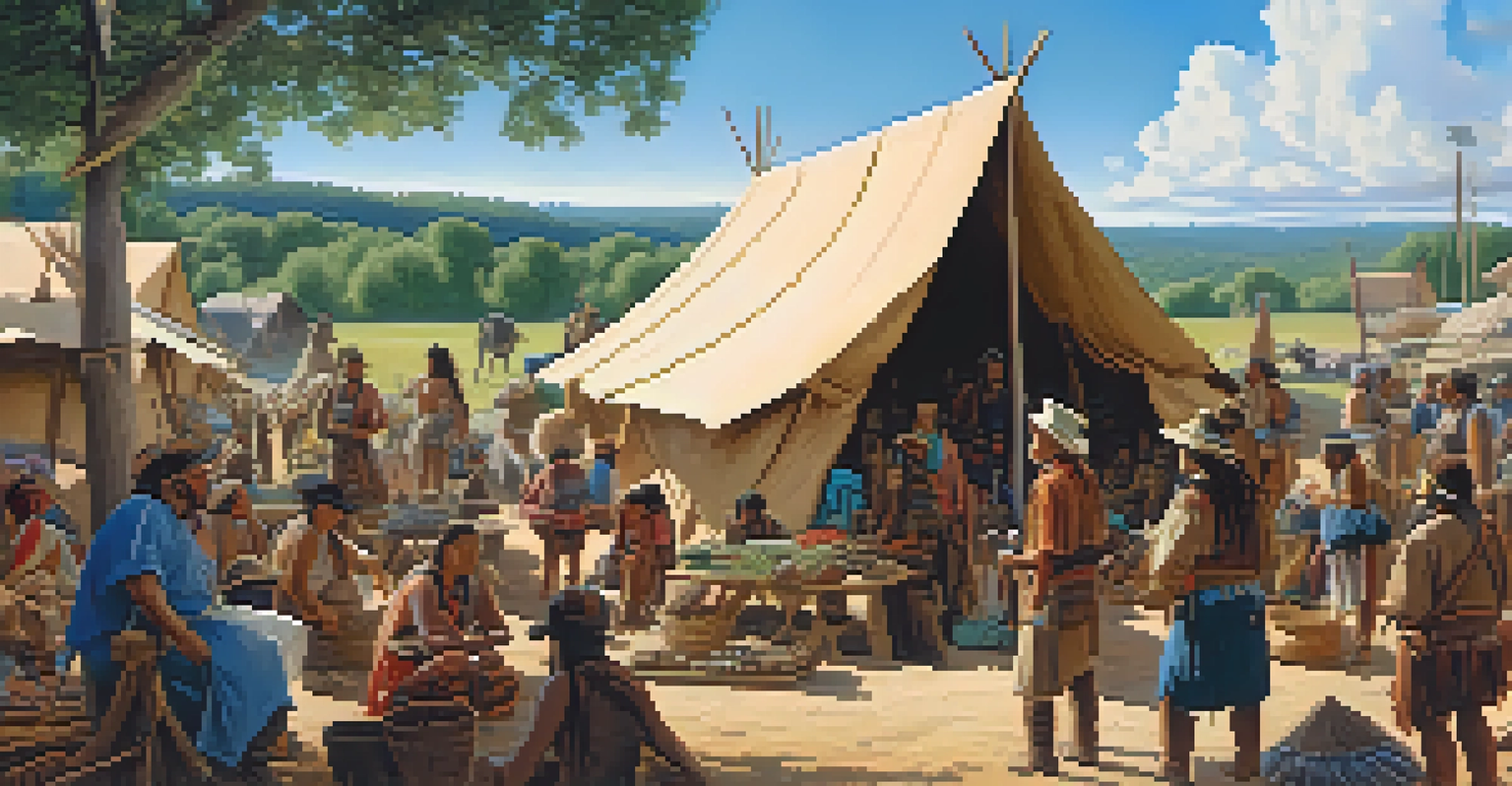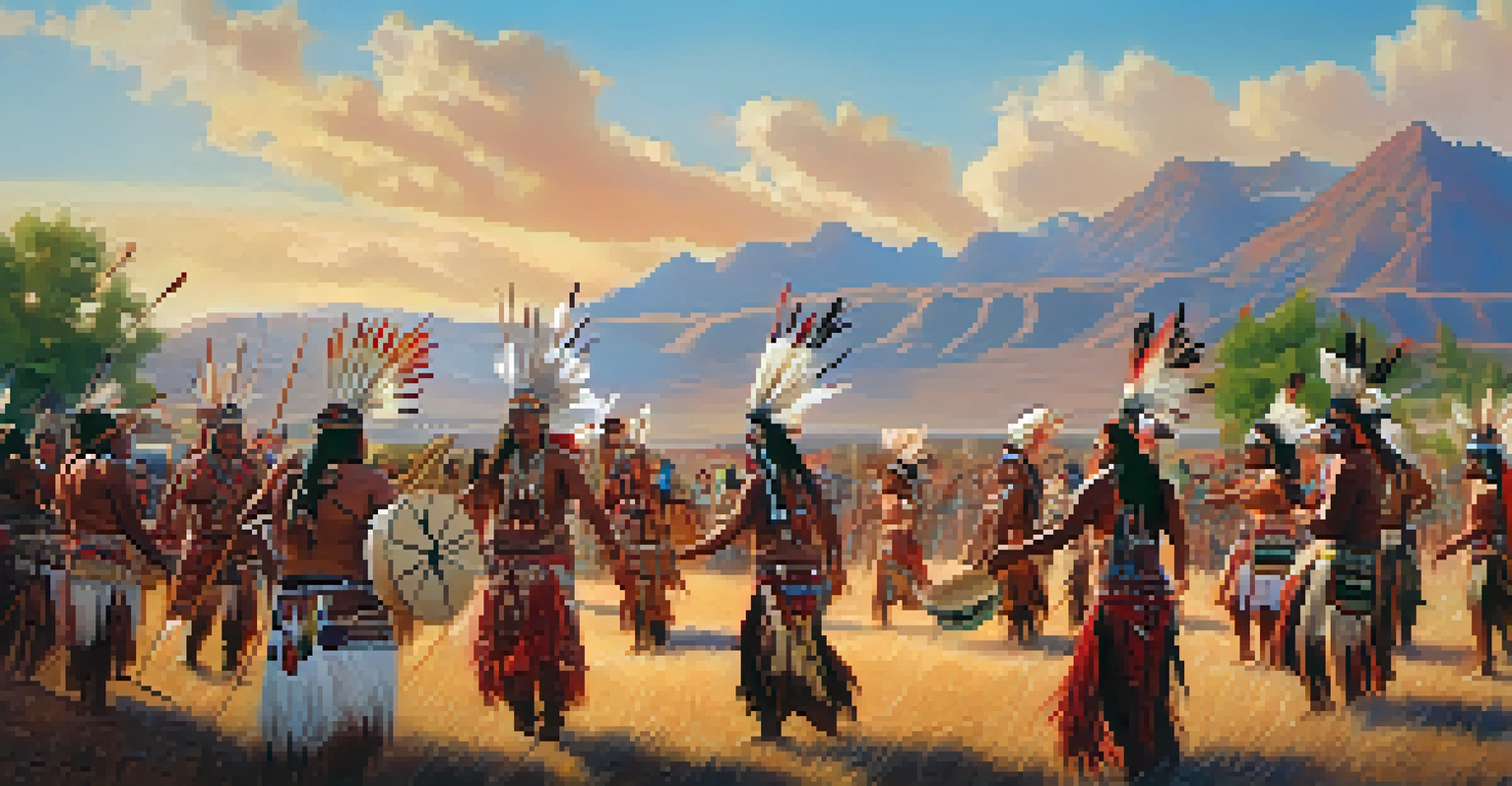Impact of European Settlement on Native American Tribes

The Arrival of European Settlers in North America
The arrival of European settlers in the late 15th century marked a turning point for Native American tribes. Explorers like Columbus and later settlers began to establish colonies, leading to profound changes in the landscape and the lives of Indigenous peoples. This influx of newcomers brought not only new technologies but also foreign diseases that decimated native populations.
The past is never dead. It's not even past.
Many tribes were unprepared for the diseases brought by Europeans, resulting in devastating mortality rates. For example, smallpox, which was virtually unknown to Native Americans, spread rapidly and caused significant loss of life. This demographic shift altered the balance of power among tribes, as some became more vulnerable to others who remained unaffected.
As settlers expanded their territories, they disrupted traditional hunting and farming practices. Native American tribes, who had long thrived through sustainable practices, found their resources dwindling, leading to conflicts over land and survival.
Cultural Exchanges Between Settlers and Native Tribes
Despite the often tumultuous relationships, there were instances of cultural exchanges between European settlers and Native American tribes. These interactions led to the sharing of agricultural techniques and trade goods, enriching both parties. For example, Native Americans introduced settlers to crops like maize and tobacco, which became staples in European diets.

Conversely, settlers brought their own practices and technologies, such as metal tools and firearms, which some tribes adopted to enhance their daily lives. This exchange was not one-sided; many tribes adapted European farming methods while maintaining their cultural identities.
Impact of Disease on Native Tribes
The arrival of Europeans brought foreign diseases that devastated Native American populations, drastically altering tribal dynamics.
However, these exchanges were often overshadowed by the violence and dispossession that accompanied European expansion. The initial curiosity and cooperation gave way to mistrust and conflict as settlers sought more land, leading to a complicated legacy of both collaboration and confrontation.
Land Displacement and Its Consequences
One of the most significant impacts of European settlement was the displacement of Native American tribes from their ancestral lands. Treaties were often signed under duress or not honored at all, resulting in the forced removal of tribes. The Trail of Tears is a notorious example, where thousands of Cherokee were forcibly relocated, leading to immense suffering and loss.
History is not a burden on the memory but an illumination of the soul.
This land displacement disrupted traditional ways of life, as tribes were often moved to unfamiliar territories that lacked resources. Hunting grounds were lost, and the spiritual connection to their land was severed, causing cultural upheaval. The loss of land also meant a loss of autonomy, as tribes became increasingly dependent on the government and settlers for survival.
As Native Americans were pushed further west, many tribes faced the challenge of adapting to new environments. This adaptation was not just physical; it also required significant shifts in their social structures and cultural practices, sometimes leading to the erosion of traditional identities.
Economic Changes for Native American Tribes
The economic landscape for Native American tribes changed dramatically with European settlement. Traditional economies based on hunting, gathering, and agriculture were disrupted, forcing many tribes to adapt to new economic realities. The introduction of trade with settlers created both opportunities and challenges, as some tribes began to rely on European goods.
While trade could bring valuable resources, it also made tribes vulnerable to exploitation and dependency. European settlers often manipulated trade relationships, leading to imbalances that favored the settlers. This economic dependence weakened tribal sovereignty and undermined traditional practices.
Cultural Exchanges Amid Conflict
Despite conflicts, there were mutual cultural exchanges between settlers and Native tribes, leading to shared agricultural practices and technologies.
Furthermore, as settlers expanded into Native lands, competition for resources intensified. Many tribes found themselves in conflict not only with settlers but also with each other, as they vied for dwindling resources. This shift in economic dynamics had long-lasting effects on the social fabric of Native American communities.
Religious and Spiritual Impacts on Native Cultures
European settlement also had a profound impact on the religious and spiritual beliefs of Native American tribes. Many settlers viewed Indigenous spiritual practices as pagan and sought to convert Native peoples to Christianity. This missionary effort often involved the suppression of traditional beliefs and practices, leading to cultural erasure.
As tribes were forced to abandon their spiritual practices, the social cohesion that these beliefs fostered began to fray. Ceremonies that were integral to tribal identity were disrupted, causing a loss of cultural heritage. This spiritual dislocation created a void that many tribes struggled to fill in the wake of enforced conversion.
However, despite these pressures, many Native American communities found ways to preserve their spiritual traditions. Syncretism emerged, blending elements of Christianity with Indigenous beliefs, allowing tribes to maintain a sense of identity in the face of overwhelming change.
Resistance and Resilience of Native American Tribes
In response to the challenges posed by European settlement, many Native American tribes exhibited remarkable resistance and resilience. Throughout history, tribes have fought to defend their lands, cultures, and rights against encroachment. Events like the Pequot War and the resistance led by figures such as Tecumseh exemplify the fierce determination of Native peoples.
This resistance was not just militaristic; it also took the form of cultural preservation and revival. Many tribes worked to maintain their languages, traditions, and social structures despite the pressures of assimilation. Grassroots movements and cultural revitalization efforts became instrumental in reclaiming Indigenous identities.
Ongoing Legacy of Displacement
The historical displacement of Native American tribes continues to influence contemporary issues such as poverty and land rights.
Today, the legacy of this resilience is evident in the ongoing efforts of Native American communities to assert their sovereignty and protect their rights. From legal battles over land to cultural festivals celebrating traditional practices, tribes continue to honor their heritage while navigating the complexities of modern life.
Modern Implications of Historical Settlement
The historical impact of European settlement on Native American tribes continues to resonate today. Many contemporary issues faced by Native communities, such as poverty, health disparities, and land rights, can be traced back to this tumultuous history. Understanding this legacy is crucial for addressing the challenges that Indigenous peoples face in the modern world.
Furthermore, the ongoing struggle for recognition and justice highlights the need for education and awareness about Native American history. As society becomes more aware of these issues, there is a growing movement to support Indigenous rights and sovereignty. This shift is essential for fostering a more inclusive narrative that acknowledges the contributions and experiences of Native peoples.

Acknowledging this history is not just about looking back; it's about shaping a future that respects Indigenous rights and promotes healing. By learning from the past, we can work towards a more equitable society where the voices of Native American tribes are heard and valued.